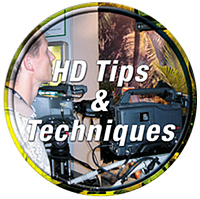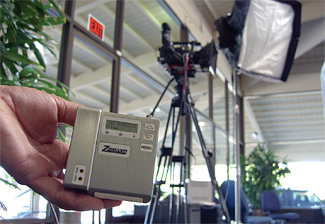HD Tips: Pro Audio for Prosumer Cameras

THOUSAND OAKS, CALIF.
The proliferation of prosumer HDV cameras has been a boon for producers looking to get the most bang for their buck. But while these smaller cameras might appear to be easier to operate than larger, more sophisticated professional HDTV broadcast cameras, they pose some significant challenges for production sound mixers.
“The prosumer production experience is a fact of life these days as budgets get tighter in this economy,” said Tomm Dauenhauer, audio supervisor/production sound mixer of Tommin8er Sound Inc. in Thousand Oaks, Calif. Dauenhauer, who has worked on a mix of reality television, documentaries, commercials, corporate productions and music videos over the last 10 years, most recently completing garden makeover show “Fix This Yard” for A&E, added, “Most of my production year has been with these cameras; the video quality is at such a high level.”
THE TIMECODE PROBLEM
Working with a professional broadcast camera for a sound mixer is a relatively simple matter of connecting the location sound rig to the camera, setting tone levels and recording to the video media. Multitrack recording with a double system audio setup (that is, a system separate from the camera’s on-board capabilities) is not a problem if there is SMPTE timecode synchronization, at the appropriate frame rate, between the recorder and camera or cameras.
But one problem with prosumer cameras is that they do not have timecode capabilities. Plus, accessing audio functionality—levels, channel selection, automatic gain control, and so on—in a prosumer camera typically involves switch settings, connectors and menus that differ from one camera to another.

On set, audio mixer Tomm Dauenhauer uses a Zaxom ZFR100 digital audio recorder with timecode Dauenhauer noted that even the popular Red One camera is a challenge: “I hate to be the one at the party to point out that the emperor isn’t wearing any clothes, but from an audio perspective the Red One camera is basically a prosumer camera with a large imaging chip and a very basic audio recording system that is at best, a challenge, with prosumer limited headroom. When one has to deal with a Red One shoot and ask 20 questions regarding build version, audio input resistance, permission from the DIT [digital imaging technician] to be allowed to hook-up to the camera with audio input cables, or sync from a [Ambient ACL202CT timecode generator] Lockit Box, or a Zaxcom Deva recorder, one has to pause and wonder why they even put audio on the camera at all.”
Experience has taught Dauenhauer to bring along a double system recording setup to any shoot. “That way, the camera crew and the DIT and the producers can thrash about, and all the while I know my sound is the best quality and remains intact on my recorder. The only thing I demand is that they put the jam-synced Deneke Timecode Slate in front of the Red One whenever it begins making a video file.”
REALITY DRIVEN
Dauenhauer is able to tailor his double system digital audio rig depending upon the requirements of the production, based around an inventory that includes a 10-channel Zaxcom Deva Fusion digital mixer/recorder, eight-channel Professional Sound Corp. Alpha Mix, PSC M-4 Mk II four-channel mixer or Sound Devices 302 three-channel ENG mixer. Wireless devices include Zaxcom RX-900S digital stereo receivers and TRX-900AA digital transmitters as well as Lectrosonics 400 and 200 series equipment. His microphone complement includes DPA, Sanken, Sennheiser and Sony lavaliers along with Audio Technica AT-4073A, Neumann KMR-81i and Shoeps CMIT-5U short shotguns.
The ZFR100, a cigarette pack-sized unit that incorporates a timecode generator/reader and can record two-channel audio continuously for up to 12 hours, is especially useful on run-and-gun shoots: “I can sync it and put it in an actor’s pocket and send him off to drive a car, or go into a situation where I can’t follow him, like live audio concerts or variety shows where the production will not allow wireless audio.”
On productions where he is able to run a wireless hop to the camera, Dauenhauer will use the TRX-900AA transmitter, which also includes a built-in two-channel chip recorder with timecode. “It’s excellent for reality shows, as it records tons of off-camera dialog that can be used for over-the-shoulder lines, or continuous listening for the field producers on IFBs to get more story points and questions for interviews at a later time. It also helps the field loggers immensely.”
Zaxcom’s ZaxNet signal distribution software further aids the synchronization process. The Deva or Fusion system generates timecode, metadata and remote control commands that may be broadcast via Zaxcom’s IFB transmitters and received by the company’s wireless transceivers.
Even basic level setting can be a challenge with prosumer cameras. “Many of these cameras don’t address levels in decibels. I usually stay in the white dot areas, not the yellow or red areas. You can bring digital audio levels up in post if the production levels are a bit low, but you can rarely salvage overmodulated tracks,” he cautioned.
The freedom of movement and agility that prosumer cameras offer can be a barrier to audio best practices. Most experienced documentary and reality production camera operators—and producers—understand that they can follow the action better if they monitor the audio. If the operator chooses not to listen, Dauenhauer may run a wireless audio send back to the mixer for monitoring.
“But on the smaller cameras it’s too much gear, difficult to run an additional return line to the butt pack, and it adds weight to the pack, so I start to get complaints from the camera operators. Additionally, the playback monitor circuits of most prosumer cameras are not very good or strong. Not to mention the delay issues that can be disconcerting to the mixer, and the difficulty in hearing any issues affecting a good recording,” he noted.
Ultimately, the best practice on a shoot is to be prepared, Dauenhauer observed: “The sound mixer who finds out what camera he’ll be working with, and downloads and reads the camera manuals before arriving at set, will have the upper hand and a good recording experience. Simple checklist techniques and good equipment in your sound mixing bag can make the difference between an excellent production experience and a disaster.”
Get the TV Tech Newsletter
The professional video industry's #1 source for news, trends and product and tech information. Sign up below.
Steve Harvey began writing for Pro Sound News and Surround Professional in 2000 and is currently senior content producer for Mix and a contributor to TV Tech. He has worked in the pro audio industry—as a touring musician, in live production, installed sound, and equipment sales and marketing—since November 1980.
